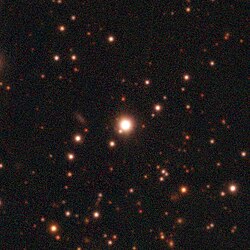Top Qs
Timeline
Chat
Perspective
Gaia BH1
Binary system containing the closest known black hole to Earth From Wikipedia, the free encyclopedia
Remove ads
Gaia BH1 (Gaia DR3 4373465352415301632) is a binary system consisting of a G-type main-sequence star and a likely stellar-mass black hole, located about 1,560 light-years (478 pc) away from the Solar System in the constellation of Ophiuchus.[4] As of May 2024[update], it is the nearest known system that astronomers are reasonably confident contains a black hole, followed by Gaia BH3, Gaia BH2 and A0620-00.[3][5]
Remove ads
Characteristics

The star and black hole orbit each other with a period of 185.59 days and an eccentricity of 0.45. The star is similar to the Sun, with about 0.93 M☉ and 0.99 R☉, and a temperature of about 5,850 K (5,580 °C; 10,070 °F), while the black hole has a mass of about 9.62 M☉.[3] Given this mass, the black hole's Schwarzschild radius should be about 28 km (17 mi).
Remove ads
Discovery

Gaia BH1 was discovered in 2022 via astrometric observations with Gaia, and also observed via radial velocity. The discovery team found no astrophysical scenario that could explain the observed motion of the G-type star, other than a black hole. The system differs from "black hole impostors" such as LB-1 and HR 6819 in that the evidence for a black hole does not depend on the mass of the star or the inclination of the orbit, and there is no evidence of mass transfer.[3] The discovery team also found a second system that is a candidate for containing a black hole, which was also reported by another team of astronomers,[3][6] and was confirmed in 2023 as Gaia BH2.[7]
The black hole was also independently detected by a second team, who found slightly different parameters.[8]
Remove ads
See also
References
Wikiwand - on
Seamless Wikipedia browsing. On steroids.
Remove ads

